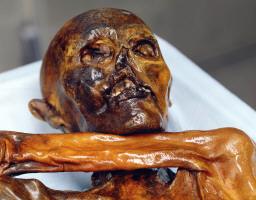Italy's famed Iceman will get company this week as mummies from all over the world arrive for a major show in this northern Italian city.
Joining the mummified neolithic hunter in his purpose-built museum here will be more than 60 mummies from Ancient Egypt, Asia, South America and Oceania, organisers said Tuesday.
''It will be the world's most comprehensive show on the history and culture of mummies,'' organisers said.
The show, which includes bog-preserved animal mummies from the Age of the Dinosaurs and human mummies up to the present day, will be accompanied by a symposium featuring the world's top palaeontologists.
The mummies, some of them naturally preserved in deserts, ice or bogs and others by the skills of men, have been gathered from 27 museums and collections across Europe.
Mummies, The Dream of Eternal Life, organised by the Reiss-Engelhorn Museums in the German city of Mannheim, will run from March 10 to October 25, 2009.
''It has been staged here because the Iceman is the most remarkable mummy, and of course, he can't leave his refrigerated cell,'' an organiser said.
As well as the mummies, the exhibition features 150 objects connected to mummies as well as 12 multimedia installations showing the latest scientific data on mummies and mummification.
The show will be the second time in three years that the Iceman - otherwise known as Oetzi from the mountain valley where he was found - will welcome mummified guests.
In 2006 he was joined by the so-called 'Cloud People' whose desiccated bodies where found high up in the Peruvian Andes in the mid-1990s.
The Cloud People, who flourished between 800 and 1500 AD, were conquered by the Incas and then killed off by diseases contracted from the Spanish Conquistadores.
The 5,000-year-old Iceman is perhaps the world's most famous mummy outside Egypt, and the oldest 'wet' mummy in the world.
The body, which dates back to 3000 BC, has spawned a global cottage industry of studies since he was found in a glacier in the Oetz mountain valley in 1991.
There have been discoveries about what he ate and what illnesses he suffered from, as well as a keen debate on how he died from the arrow wound found in his body - initially, it was thought, in a fight with rival hunters.
One theory says he was assassinated in a tribal power struggle.
Another suggested he was the victim of ritual sacrifice.
Another study - fiercely contested by patriotic residents of this formerly Austrian region who see Oetzi as their proud forefather - reckons he was cast out from his community because a low sperm count rendered him childless.
An eerie aura has also grown around the Iceman because of the allegedly mysterious deaths of seven people who came into contact with him.
